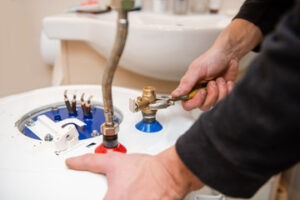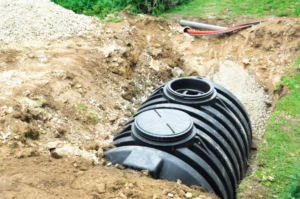Water heaters provide us with the hot water we need for showering, washing laundry and dishes. But sometimes they need repair or even replacement.

If your hot water smells like sulfur or looks discolored, you may have a problem with the anode rod. Draining the tank and replacing the anode rod can help prevent this problem from recurring.
If your water has a metallic taste or smell, it could be a sign of iron corrosion in your hot water tank. Corrosion is most often caused by a faulty anode rod. An anode rod is a metal rod in the center of your tank that attracts corrosive molecules. If the anode rod corrodes, it can release rust into your water. It should be replaced at least once every 2 years. Having an anode rod in place is critical to protect your water heater and help extend its life.
Sediment buildup in your water heater tank can also cause discolored water. A layer of sediment insulates the heating elements from the water, which makes it take longer for your tank to heat your water. You can flush your tank each year to remove this sediment, improve water quality, and reduce energy consumption.
Another water heater issue that could lead to poor water quality is a broken or malfunctioning pressure relief valve (PRV). A functioning PRV relieves excess pressure in the tank and prevents explosions inside the hot water heater. If your PRV is leaking, you will need to have it repaired or replaced right away.
Your water heater’s temperature setting should be between 120degF and 115degF to avoid bacteria growth. If the water is too hot, it can damage your pipes and fixtures. If your water is too warm, it can cause scalding injuries and damage your pipes. You can keep your water at the proper temperature by maintaining an adequate water supply and by installing a water softener or descaling agent.
A puddle of water around your hot water heater is another indicator that it needs to be repaired or replaced. If left unattended, a leaky water heater can lead to flooding, water damage, and mold infestations. Leaking water can also harm pets and children, compromise indoor air quality, and damage your home’s structure. You can avoid these problems by having a professional water heater repair service inspect your unit for signs of a leak or a faulty pressure relief valve.
Leaks
Leaks in a water heater are very serious, because a small leak can quickly turn into a large puddle or flood. This can cause expensive damage to floors, walls and furniture. The leaking water can also eat away at the metal of the unit, causing further problems. It is important to understand where and why a leak happens, so you can fix it quickly before it causes severe damage.
Water Leaks from the Bottom
A leaking water heater tank often means you have a leaky drain valve. You can try to tighten the drain valve with a pipe wrench, but it may be necessary to replace it completely to prevent further leaks. If you have a gas water heater, make sure the gas line is turned off before trying to tackle this issue, as it could result in an explosion.
The bottom of the tank can leak due to sediment or minerals build up. You can try flushing the tank to resolve this issue, but if it continues to leak, you will need to replace the entire tank.
Water Leaks from the Top
Water leaks from the top of a water heater are usually caused by loose pipe connections. The inlet and outlet connections allow cold water to enter the tank and hot water to exit into your home’s water fixtures, so loosening these can result in leaking water. Loose connections are usually easy to repair, but sometimes a replacement is necessary. Water leaks from the top of a tank can also be caused by a faulty temperature and pressure relief valve (T&P). This safety mechanism releases water when there is too much pressure inside the tank. In most cases, simply replacing the T&P valve will solve this problem.
Water leaking from the sides of a water heater can be more difficult to resolve. It can indicate a cracked or corroded water heater. It is also possible that a faulty anode rod is to blame. An anode rod is a metallic rod that attracts corrosive material to it, protecting the water heater from corrosion. If your anode rod is corroded, it can’t do its job and should be replaced as soon as possible.
Age
Your water heater is an important part of your home that you often take for granted until something goes wrong with it. Then, you’re left without a hot shower or the ability to wash dishes and laundry. Luckily, water heaters have fairly predictable lifespans and there are some key signs that it’s time for an upgrade.
Constant repairs or leaks around your tank are a clear indicator that it’s nearing the end of its life. While you may still be able to repair some components, such as a faulty valve or a broken heating element, replacing the entire unit is usually a better option for your long-term health and comfort.
A lack of hot water is another sign that your water heater needs to be replaced. If you’re finding that you have to turn the temperature up on your shower to get warm water, this is a clear sign that your heater is not working as efficiently as it used to, and it will likely result in higher energy bills.
Inconsistent water temperatures are also a sign that your heater is reaching the end of its lifespan. If you notice the water ranging from hot to cold, this could be caused by a failing thermostat or heating elements. A replacement is probably the best choice in this case, as a newer, more efficient model will save you money in the long run.
You can find out your water heater’s age by looking at the serial number on its label. The first two numbers represent the year it was made. If your water heater is over ten years old, it’s definitely time to consider a replacement.
Maintaining your water heater through routine maintenance and keeping on top of any repairs will help it to last longer. Be sure to drain your tank about twice a year to keep it free of sediment that can cause corrosion and damage. It’s also a good idea to check the anode rod, also known as a sacrificial rod, every three years. If this aluminum rod is caked with sediment or rusted out completely, you will need to replace it immediately.
Noise
While operational noise from a hot water heater is fairly normal, loud knocking, screeching and other sounds should always raise concerns. These loud cries for help can signify serious issues such as tank corrosion, water leaks, component failure and even dangerous electrical issues. Ignoring these noisy hints will allow problems to escalate into costly breakdowns or safety hazards. Fortunately, most noisy situations can be addressed with some quick DIY troubleshooting and/or simple professional repair.
Banging and rumbling noises can often be caused by sediment buildup that reacts with the heating elements in your electric unit. This can cause the elements to become loose and vibrate, creating these rumbling sound effects. This can be a simple issue to solve by draining your water heater tank to remove the excess sediment.
Sizzling sounds can also be a big sign that your hot water heater needs replacing. These sounds are usually a result of minerals and sediment wearing down the surface of your gas or electric water heater. Replacing your water heater’s elements will eliminate these loud sizzling sounds and prolong the life of your unit.
Ticking or tapping sounds are typically a sign of problems in your pipes rather than your water heater. These sounds can be a sign of worn out heat traps or changes in water pressure that cause parts to loosen. Loose pipe straps or other simple fixes can quickly resolve this issue.
Loud squeals and screeching sounds are signs of water being forced through small openings under high pressure. This can happen with water leaking from the bottom of your tank or from pinholes or loose valves in your home’s plumbing. This can also occur if the gas pilot light is not kept properly lit, which requires professional help from a qualified HVAC technician.
While some of these disruptive noises may be mitigated with DIY solutions, any rumbling, tripping or whining noises should be treated as clear warning signs that your hot water heater isn’t functioning properly and that you need to call in the pros. These issues signal major mechanical or electrical problems and should never be tinkered with by inexperienced homeowners. The best way to avoid costly and disruptive water heater issues is to invest in consistent annual preventive maintenance. This small investment will pay off in big ways by preventing major breakdowns, expensive repairs and priceless peace of mind.
